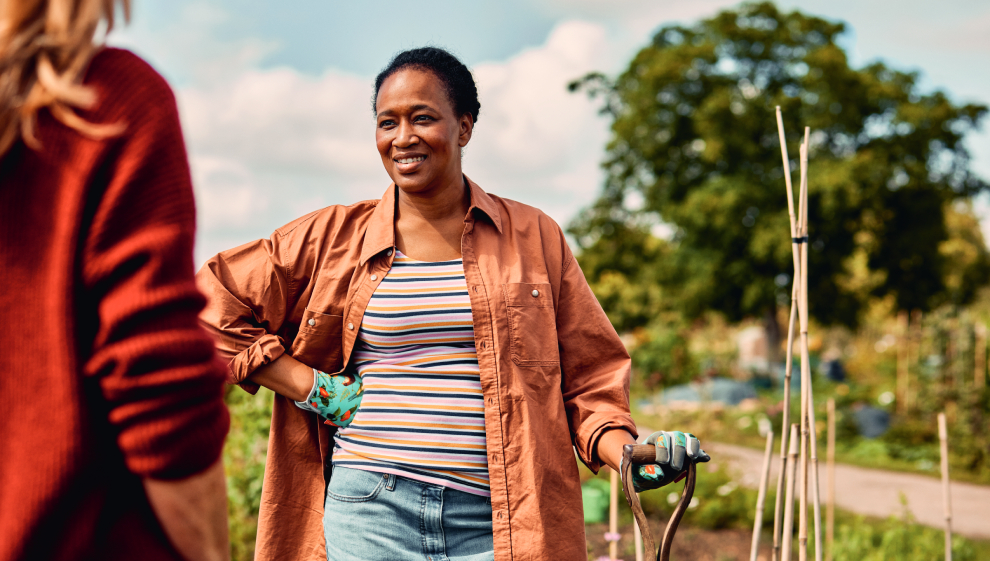Joint pain | 7 at-home exercises for seniors
- Overview
- Why is exercise important as we age?
- Stay active at home
- What equipment will I need?
- 1. Chair squats (sit to stand)
- 2. The stork (single leg stands)
- 3. Wall snow angels
- 4. Rotations
- 5. Wall push-ups
- 6. Overhead lifts
- 7. Stair stepping
- The free Nuffield Health Joint Pain Programme
- Start low and slow
- Related articles
Why is exercise important as we age?
If you are starting to get active again, good for you.
Maintaining a regular exercise and activity regime helps us live our best life when we retire. The older we get, the harder it becomes to kickstart an exercise plan due to gradual muscle loss, mobility issues, depleted motivation, and the onset of joint pain.
No matter our age, it’s important we use our muscles regularly to maintain bone strength, muscle strength, coordination, and a healthy heart.
Stay active at home
Think you need a gym membership to stay active? Think again. We’ve put this specific set of exercises together to help you get and stay active at home without the need for fancy equipment or a gym membership.
These exercises are designed to be done quickly in the morning, during the day, or right before you go to bed. Making them part of your routine will help you stay limber, feel looser, and maintain good joint health as you age.
What equipment will I need?
- A clear space where you are not going to slip or fall on an object
- A wall space
- Chair (with arms if needed)
- Stable surface to hold for balance exercises
- A broom or stick handle
- Towel
- A bottle of water
1. Chair squats (sit to stand)
Chair squats are a safe and assisted way of strengthening the muscles in your lower body, bones and joints.
If you can’t squat lower than 90° at the hips, chair assisted squats are a great way to get all the benefits of squatting without putting unwarranted strain on your joints.
- Stand in front of a chair with your feet as far apart as your hips
- Bend your knees while keeping your shoulders and chest upright
- Lower your bottom slowly (4 seconds) so you sit down
- Then push your body back up to return to a standing position (2-4 seconds)
- Try to avoid using your hands
- Perform this 5-10 times or for a duration of 20-60 seconds, and take a rest after for 40-60 seconds
- Repeat this action 2-5 times.
2. The stork (single leg stands)
Storks (or single leg stands) help improve mobility in our hips. Don’t rush this exercise, as this can cause pain and discomfort in your hips.
Remember, hold onto a stable surface like a worktop or chair if you feel off balance at any point.
- Stand facing a non-moveable chair or surface for support if you need it
- Warm up with a slow march for 1 minute, gradually raising your knees higher
- With your arms at your side, slowly lift your left foot and balance on your right foot for 10 seconds
- Slowly lower your left foot and repeat with your right foot
- Aim to build up the duration by 5 seconds each time as you feel more comfortable
- To increase difficulty, try raising your hand above your head on the same side or slowly swinging your arms like you’re running
- Repeat on both legs 3-5 times each.
3. Wall snow angels
Wall snow angels are a safe way to improve mobility, posture, and strength. If you have limited range of motion in your shoulders, this unique circular movement can help.
- Stand with your upper back, head, bum and heels against the wall
- Start with your hands out to the side with your palms facing outwards
- Whilst maintaining contact with the wall, slowly raise your hands above your head, stretching as wide and as high as possible
- Slowly return to your starting position and then repeat – aim to complete 5-10 times
- Perform this 2-3 times, and take a break for 40-60 seconds before repeating again.
4. Rotations
Rotations are all about improving your upper body and back mobility. You can use a towel, resistance band, broom or stick when performing this exercise.
- Holding a stick or broom horizontally behind your head, stand with your feet hip width apart and your knees slightly bent
- If you don’t have a broom, put your hands on your shoulders keeping your arms at 90 degrees
- Keeping the broom straight, turn to your right as far as comfortable, twisting through your hips
- Then slowly turn to the other side, building up your range of movement
- Repeat 10-20 times
- Perform this 2-5 times, and take a break for 40-60 seconds before repeating again.
5. Wall push-ups
Wall push ups are a slightly more advanced exercise designed to maintain upper body strength and bone mineral density.
If you have limited upper body strength, you can adjust the angle of the exercise to provide more lower body support.
- Stand at arm’s length in front of a wall which is safe
- Lean forward slightly and put your palms flat on the wall at shoulder height
- If you are just starting out have your feet closer to the wall
- If you want more of a challenge have your feet further back from the wall
- Keep your feet planted as you slowly bring your body towards the wall, aiming to keep your body straight
- Gently push yourself back so that your arms are straight again
- Aim for 5-10 slow repetitions
- Perform this 2-5 times, and take a break for 40-60 seconds before repeating again.
6. Overhead lifts
This highly functional set of movements improve upper body strength and movement in the back and shoulders. You can do these movements without weight or with a small dumbbell that you’re comfortable lifting up and above your head.
- In a standing position hold 2 evenly weighted objects like cans of beans or bottles
- Start with your hands down by your sides and your palms facing away from you
- Keeping your elbows by your side, slowly bring the objects up to your shoulders then slowly extend your arms above your head
- Reverse the action until your hands are back by your side
- Repeat the movement 5-10 times
- Perform this 2-5 times, and take a break for 40-60 seconds before repeating again.
7. Stair stepping
Last but not least, stair steppers are a great way to improve coordination, aerobic fitness for heart health and lower body strength.
If you struggle with mobility or climbing the stairs is becoming increasingly difficult, use a stair step to build confidence and lower body stability.
- Stand in front of a staircase or step and step up with your right foot, then up with your left
- Then step back down with your right, then back down with your left. Repeat 10 times or for a period of 20-60 seconds
- Take a rest before changing the leading foot
- If you need a little support, hold on gently to the railing, or gently touch the wall with your fingertip
- If this is comfortable, to increase difficulty, hold some weight in each hand such as a bottle of water
- Perform this 2-5 times, and take a break for 40-60 seconds before repeating again.
The free Nuffield Health Joint Pain Programme

If you suffer with chronic joint pain and are unsure where to turn, our free Joint Pain programme is a great place to start. The totally free programme runs for 6 months and helps you access information and professional help about your condition.
The best thing about our Joint Pain Programme is that it works. If you’re tired of living with chronic joint pain, professional help allows you to self-manage your pain and lead a more independent life.
Looking for more information? Click here to sign up
Start low and slow
No matter what your age or ability, you should always start a new exercise regime slowly.
You can always add weight and up your reps accordingly. Unfortunately, recovering from an injury isn’t that easy. Starting slowly allows you to safely build up over time as your body gets used to these new movements.
Last updated Friday 13 October 2023
First published on Friday 27 March 2020

